| Article ID | Journal | Published Year | Pages | File Type |
|---|---|---|---|---|
| 7176455 | Journal of Materials Processing Technology | 2018 | 17 Pages |
Abstract
In this study, a high-temperature hardness tester was developed, and its basic structure, main performance and advantages were introduced. The high-temperature hardness tester has three main advantages: it significantly prevents the oxidation of the sample and the indenter; it does not affect the stiffness of the bearing platform; and ensures the accurate measurement of the relevant image at high temperatures. Then, the Vickers indentation test was carried out using the developed hardness tester. The contact surface of the indenter and the sample was found to be a curved surface, and the height of the middle of the indentation edge was found to be higher than the height of the indentation corner. Therefore, a three-dimensional model of indentation morphology was established, and hardness values at different temperatures were corrected. It was found that the hardness of CTS18D cemented carbide decreased with increasing temperature, and the value decreased by approximately 35% from room temperature to 1000â¯Â°C. In addition, at the same temperature, the corrected hardness value was smaller than the measured hardness value. Moreover, the difference value between the measured hardness and the corrected hardness decreased from 3.9% to 3.2% with an increase in temperature from 26â¯Â°C to 1000â¯Â°C.
Related Topics
Physical Sciences and Engineering
Engineering
Industrial and Manufacturing Engineering
Authors
Bicheng Guo, Libin Zhang, Liang Cao, Tao Zhang, Feng Jiang, Lan Yan,
